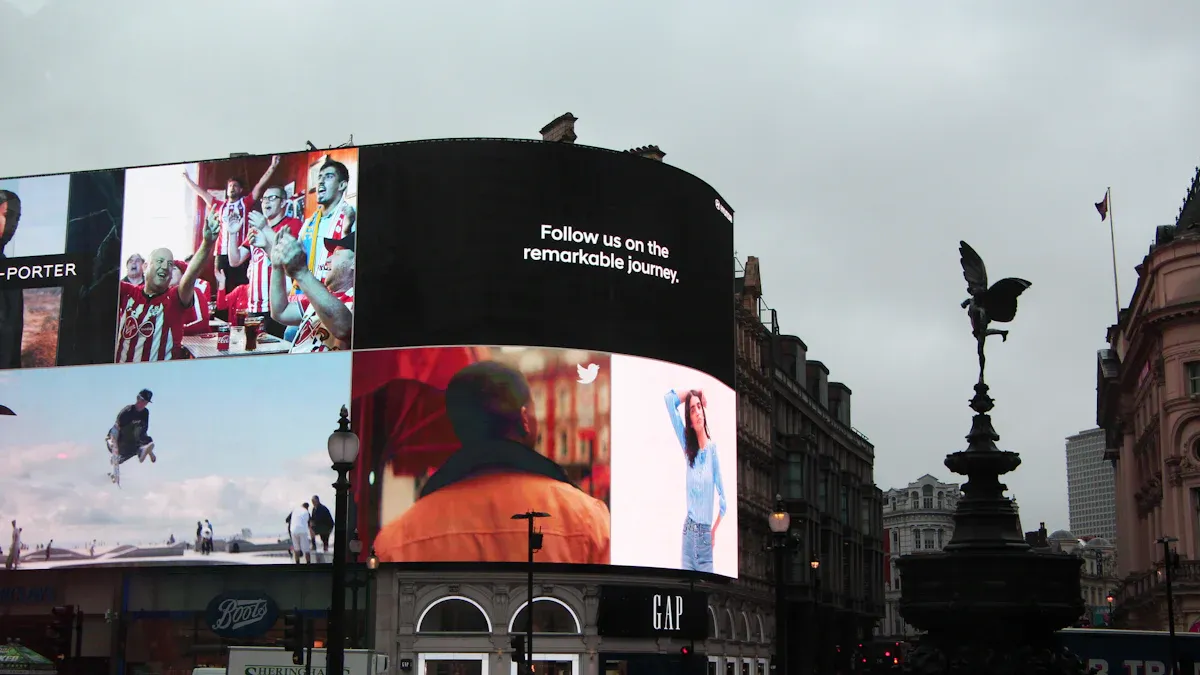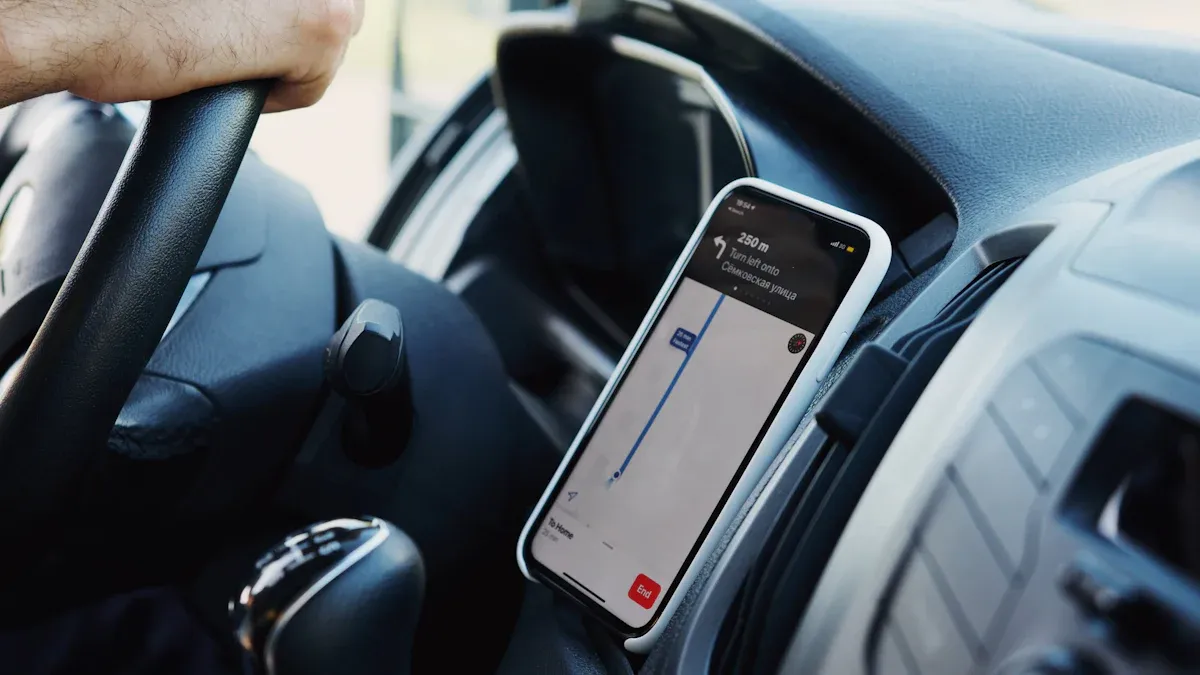
You can update taxi ads right away with real-time gps taxi ad content scheduling. For example, when a taxi goes into a busy shopping area, the screen inside shows a store’s ad for that place. This system uses GPS, ad management software, and display units. Advertisers get better brand recall and more accurate targeting. Taxi operators like the automatic scheduling and better work efficiency. With real-time updates, you can see results that make transportation ads react faster.
Key Takeaways
Real-time GPS helps show the best ads in taxis. It uses the taxi’s exact location. This makes ads more useful and on time.
Geofencing sets up invisible zones in busy places. Ads show up when taxis go into spots like malls or airports. This helps reach the right people.
The system has GPS devices, communication parts, ad software, and strong screens. These work together to send and change ads by themselves.
AI and cloud tools help control lots of taxis. They update ads quickly and make ad targeting better. They use live data like traffic and events.
Watching how ads do and keeping passenger privacy safe is important. This helps ads work well and builds trust with riders and drivers.
Real-Time GPS Taxi Ad Content Scheduling

Overview
Real-time gps taxi ad content scheduling helps make ads work better. Gps fleet tracking shows where each taxi is right now. This means you can send ads to the right place at the right time. As taxis drive around, gps devices collect data about their location. The ad management system uses this gps data to pick what ads to show on taxi display units. You do not need to guess where your ads will go. Gps fleet tracking lets you control which ads show up based on location.
Taxi operators link gps fleet tracking with dispatch systems and digital signage. This setup helps you handle ads for many taxis together. You can change ads quickly so each taxi shows the best ad for its area. Gps fleet tracking also lets you check how well your ads do and change your plan fast.
Value for Taxi Advertising
Real-time gps taxi ad content scheduling gives you a big edge in transportation advertising. You can use gps triggers to show ads when taxis enter special places. Geofencing sets up invisible lines around spots like airports, hotels, or shopping centers. When a taxi goes into one of these places, a gps trigger tells the system to show ads for that location.
Geofencing helps you show ads to people near busy places like nightclubs or malls.
Gps triggers make sure your ads show up at the best time, so more people pay attention.
You can see how many people notice your ads and if they visit the place later.
Gps fleet tracking helps you reach people inside the taxi and after they leave.
This way, you connect better with your audience and get more value from your ads.
Gps fleet tracking and real-time gps taxi ad content scheduling let you share ads that change with location. You make your transportation ads smarter, quicker, and more useful.
Components

GPS Tracking Devices
Every taxi needs a gps tracking device. These devices collect gps data about where the taxi is. The gps tracking device sends this data to the main system. You can always see each taxi’s location. Gps fleet tracking shows if a taxi is near busy places or special zones. This helps you show the right ad at the right time. Gps tracking devices are small and fit inside taxis. They work all day and send gps data without stopping.
Communication Modules
Communication modules send gps data from taxis to the cloud. They use cellular or satellite networks. You get live updates about the taxi’s location and status. Gps fleet tracking needs these modules for real-time updates. The system uses this data to make quick choices. You can change ads or update schedules right away. Communication modules make gps fleet tracking fast and reliable.
Ad Management Software
Ad management software controls which ads show on taxi displays. You use gps fleet tracking data to pick the best ad for each place. The software connects to gps tracking devices and communication modules. You can set rules for when and where to show ads. The software lets you check how well your ads do. Gps fleet tracking gives the software the data it needs. You can manage many taxis at once and keep ads fresh.
Display Units
Display units show ads to people inside and outside taxis. These units must be strong and easy to see. Here is a table with the main technical needs for display units:
Technical Aspect | Requirement / Description |
|---|---|
LED Modules | High-brightness SMD LEDs for clear visibility day and night |
Enclosure | IP65-rated housing for weather resistance and durability |
Power Supply | Runs on 12-24V DC from the taxi’s system |
Adaptive Lighting | Sensors adjust brightness for day/night and save energy |
Content Control | Android/Linux controllers with local storage for smooth playback |
Connectivity | Supports 4G/5G/Wi-Fi, USB/HDMI, and gps integration |
Display Features | Double-sided, shock-resistant, dust and waterproof |
Intelligent Control | IoT integration for dynamic content and time-based ads |
Installation & Operation | Low wind resistance, remote scheduling, real-time content updates |
Power Management | Monitors voltage to prevent battery drain |
Campaign Management | Central dashboard for remote uploads and fleet-wide sync |
Environmental Resistance | IP65 or higher, shock-resistant for outdoor use |
Real-Time GPS Tracking
Gps fleet tracking uses real-time gps tracking to follow taxis. You get updates every few seconds. Many systems use Google Maps API for gps fleet tracking. This lets you see taxis on a live map. You can track taxis, manage dispatch, and schedule ads using gps data. Gps fleet tracking works with cloud backend systems. These cloud systems handle lots of gps data and keep things running smoothly. You can add more taxis as your fleet grows. Gps fleet tracking and cloud backends help your ads reach the right place at the right time.
Tip: Gps fleet tracking with Google Maps API gives you real-time control. It helps you make smart choices for your taxi ads.
Process
Integration of GPS Data
First, you connect gps tracking devices in each taxi. These devices send real-time location data to your main system. The system uses gps fleet tracking to show where taxis are. You can see taxis on a live map and use this data for ads. The ad management software gets real-time gps data from the taxis. This helps you match ads to the right place. You do not have to guess where taxis are. The system updates by itself, so ads always fit the location.
Tip: Gps fleet tracking lets you manage many taxis at once. You can keep your ads new and right for every passenger.
Geofencing Setup
Geofencing lets you control when and where ads show up. You use a map to draw virtual lines, called geofences, around places like airports or malls. Here is how you set up geofencing:
Log into the map and pick the taxi or device you want.
Set the geofence by choosing the center and size.
Pick notification settings and add emails for alerts.
Save the geofence setup.
Change or fix geofenced areas whenever you want.
When a taxi enters or leaves a geofenced area, gps triggers actions. The ad management software can change the taxi’s display right away. This lets you use location-based marketing and show ads that fit where the taxi is. You can also send special offers or alerts to passengers based on their spot.
Geofencing uses gps to follow taxis as they move. The system can send alerts or update ads and fares when taxis cross a geofence. This helps you reach the right people with the right ads at the best time.
Automated Content Delivery
Automated content delivery makes your work easier. You put Android tablet kiosks or display units inside taxis. These devices show ads and other things to passengers. The system sends new ads based on gps, time, and what is happening nearby. You can use geo-targeting to make sure ads fit the area. For example, a taxi near a stadium can show sports ads.
Tablets use gps to get real-time location and update ads.
The system uses mobile device management to keep tablets safe and working.
Passengers can use touchscreens, videos, or games to interact with ads.
The platform can also show news, weather, or city guides for passengers.
You do not need to update each taxi by hand. The system sends new ads to all taxis at once. This saves time and keeps ads current.
Multi-agent scheduling systems and AI-driven optimization help you deliver ads faster and smarter. These systems use many AI agents to do tasks at the same time. They can use live gps data, traffic, and weather to change schedules. AI can guess busy times and change ads to match demand. The system can also pick better routes, cut delays, and make sure each taxi shows the best ad.
Multi-agent AI splits jobs among agents, making the system faster and more flexible.
AI can react to changes, like traffic jams or sudden events, and update ads fast.
The system keeps working even if one part stops, so ads keep running.
AI helps you use your resources better and avoid mistakes.
Performance Monitoring
You need to check how well your system works. Real-time gps tracking lets you see every taxi on a live map. You can check if taxis are in the right place and if the right ads are showing. The system sends alerts if a taxi leaves a geofenced area or if there is a problem with the display.
You get reports on fuel use, miles, and driver actions.
The system checks engine health and plans maintenance.
You can see how drivers act, like speeding or idling, and help them do better.
The platform tracks how many people see or use your ads.
You get alerts for unsafe driving, after-hours use, or geofence breaks.
AI dashcams and driver scorecards help keep drivers safe.
You can see all this information from your phone or computer. The system gives you real-time updates and detailed reports. You can use this data to make your ads better, save money, and keep taxis running well.
Note: Watching performance helps you find problems early and make better choices. You can keep your ads working and your taxis safe.
Features
Real-Time Updates
Gps lets you follow every taxi and change ads fast. You can see taxis on a live map right away. This helps you know where taxis are and what ads they show. The table below lists key real-time update features for taxi ad scheduling platforms:
Feature | Description | Benefit |
|---|---|---|
Geo-Location | Watches pickup and drop-off spots as they happen. | Makes rides safer and more efficient. |
Route Tracking | Shares live traffic and route changes. | Helps taxis get places faster. |
In-App Messaging | Lets drivers and riders talk in the app. | Fixes problems quickly. |
Safety & Security | Uses gps for emergencies and safe logins. | Builds trust and keeps information safe. |
You get exact arrival times and can see where drivers are. This makes rides smoother and helps people trust the service.
Dynamic Content
Dynamic content lets you show the best ad at the best time. You can switch ads using gps, time, or special events. For example, taxis near concerts can show music ads. You can add fun things like touchscreens or QR codes. Passengers can play games or scan codes for deals. This makes ads more fun and keeps people watching. Gps and travel data help you pick better ads and get better results.
Pick ads using rider data and travel patterns.
Analytics
Analytics tools help you see how your ads are doing. You can track views, reach, and clicks as they happen. Platforms like Domo show all your data in one place. You can check which ads work best and change your plan. Machine learning and gps help you find the right people and make ads better. Computer vision can also help you learn about your audience and make smarter choices.
Compliance
You must keep passenger data safe when using gps for ads. Real-time gps systems use private info like locations and payments. You have to follow privacy laws like GDPR. Always ask users before using their data and use strong security. Make sure your system is built to protect privacy and stop leaks. This helps people trust you and keeps your service legal.
Note: Always check your privacy settings and update your security often.
Scalability
Your system should grow as your taxi fleet gets bigger. Cloud services let you add more taxis and handle more gps data. This does not slow things down. Basic systems can cost $20,000 or more if you want extra features. Using cloud services helps you control costs and keep things running well. As more people use taxis, it is smart to invest in scalable gps ad scheduling for future success.
Real-time GPS taxi ad content scheduling helps you deliver the right ads at the right time. You boost ad impact and make your fleet smarter. For a smooth rollout, try these tips:
Pick a system with internal memory for trip data during outages.
Add features like location detection, route planning, and strong security.
Use cloud-based tools for easy scaling.
Maintain and update your software often.
Set up real-time alerts to improve safety and service.
Start planning today to make your taxi ads work smarter and reach more people.
FAQ
How does GPS help schedule taxi ads?
GPS shows where each taxi is in real time. You can use this data to send the right ad to the right place. This helps you target your audience better and improve ad results.
Can you change ads while the taxi is moving?
Yes, you can update ads anytime. The system uses live GPS data and cloud software. You do not need to stop the taxi. Ads change automatically based on location or time.
Is passenger data safe with GPS ad systems?
You must protect passenger data. Good systems use encryption and follow privacy laws like GDPR. Always ask for permission before collecting data. This keeps your service safe and legal.
What happens if the internet connection drops?
The system stores ads and trip data on the taxi’s device.
When the connection returns, it updates everything.
Your ads keep running, so you do not lose service.
How much does it cost to set up real-time GPS ad scheduling?
Costs depend on your fleet size and features. Basic systems start around $20,000. You may pay more for advanced analytics, cloud storage, or extra security. Always compare options before you choose.
See Also
Best CarPlay Devices Compatible With VW Golf In 2025
Leading Wireless Adapters For CarPlay And Android Auto Now
Best Wireless Android Auto Devices For Audi Vehicles 2025
Reviewed Best Motorcycle GPS Units Featuring CarPlay And Android Auto
